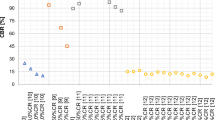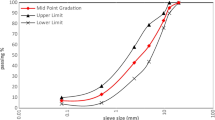Abstract
With the increased knowledge of sustainable pavement construction, recycled materials more and more are being used in roadwork applications, especially as base materials. Among various recycled materials, recycled glass aggregate is of the special attraction in the present study. The main goal of this investigation is evaluating the behavior of base course containing recycled glass using resilient modulus (Mr) from laboratory testing. In this regard, recycled glass (RG) is replaced the same range size of the local base course material (MG20) based on volumetric method. The studied RG aggregate was in the range size of 0–5 mm. The results revealed that as RG content increased, Mr values of blends decreased. Furthermore, the shear strength of blends followed the similar trend as it decreases by RG contents. Finally, based on the experimental observation a model was proposed to interpret the effects of RG on the resilient modulus values of blends. Conclusively, using RG up to 25% of MG20 may change the growing trend of environmental problems, in a green way, without significant effects on the mechanical behavior.







Similar content being viewed by others
References
Mohapatra PK, Kumari B (2017) Behaviors of intermediate layer “BASE COURSE” used on the construction of highway. Int J Mod Trends Sci Technol 3(8):44–49
Lekarp F, Isacsson U, Dawson A (2000) State of the art. II: Permanent strain response of unbound aggregates. J Transp Eng 126(1):76–83
Christopher BR, Schwartz C, Boudreau R (2006) Geotechnical aspects of pavements. National Highway Institute Federal Highway. Administration U.S. Department of Transportation Washington, D.C
Rahbar-Rastegar R (2017) Cracking in asphalt pavements: impact of component properties and aging on fatigue and thermal cracking. University of New Hampshire, Durham
Craciun O, Lo S-CR (2009) Matric suction measurement in stress path cyclic triaxial testing of unbound granular base materials. Geotech Test J 33(1):33–44
Bilodeau J-P, Doré G (2012) Water sensitivity of resilient modulus of compacted unbound granular materials used as pavement base. Int J Pavement Eng 13(5):459–471
Heydinger A, Xie Q, Randolph B, Gupta J (1996) Analysis of resilient modulus of dense-and open-graded aggregates. Transp Res Rec J Transp Res Board 1547:1–6
Bilodeau J-P, Plamondon CO, Doré G (2016) Estimation of resilient modulus of unbound granular materials used as pavement base: combined effect of grain-size distribution and aggregate source frictional properties. Mater Struct 49(10):4363–4373
Tarmuzi N, Jaya R, Yaacob H, Hassan N, Aziz M (2015) Aggregate angularity effect on porous asphalt engineering properties and performance. J Teknol 73(4):99–104
Lekarp F, Isacsson U, Dawson A (2000) State of the art. I: resilient response of unbound aggregates. J Transp Eng 126(1):66–75
Alexandria V (2013) The aggregates handbook. National Stone Association, Alexandria
Werkmeister S (2003) Permanent deformation behaviour of unbound granular materials in pavement constructions. University of TU Dresden, Germany
Cerni G, Cardone F, Virgili A, Camilli S (2012) Characterisation of permanent deformation behaviour of unbound granular materials under repeated triaxial loading. Constr Build Mater 28(1):79–87
Mishra D, Tutumluer E (2012) Aggregate physical properties affecting modulus and deformation characteristics of unsurfaced pavements. J Mater Civ Eng 24(9):1144–1152
Center CW (1998) A tool kit for the use of post-consumer glass as a construction aggregate. Rep No GL-97-5, Washington
Wartman J, Grubb DG, Strenk P (2004) Engineering properties of crushed glass-soil blends. In: Geotechnical engineering for transportation projects, pp 732–739
Senadheera S, Nash P, Rana A (2005) Characterization of the behavior of granular road material containing glass cullet. In: 7th International Conference on the Bearing Capacity of Roads Railways and Airfields BCRA05 Texas, USA
Ali MMY, Arulrajah A, Disfani MM, Piratheepan J (2011) Suitability of using recycled glass-crushed rock blends for pavement subbase applications. In: Geo-frontiers congress 2011-ASCE 2011
Arulrajah A, Ali MMY, Disfani MM, Horpibulsuk S (2014) Recycled-glass blends in pavement base/subbase applications: laboratory and field evaluation. J Mater Civ Eng 26(7):04014025. https://doi.org/10.1061/(ASCE)MT.1943-5533.0000966
Fredlund DG (2005) Unsaturated soil mechanics in engineering practice. J Geotech Geoenviron Eng 13200(286):1090–2413. https://doi.org/10.1061/ASCE1090-02412006132:3286
ASTM (2011) D2487 Standard practice for classification of soils for engineering purposes (Unified Soil Classification System). ASTM International, West Conshohocken. www.ASTM.org
ASTM (2012) D1557, 2012. standard test methods for laboratory compaction characteristics of soil using modified effort (56,000 ft-lbf/ft3 (2700 kN-m/m3)). ASTM International, West Conshohocken
ASTM (2010) D854 Standard test methods for specific gravity of soil solids by water pycnometer. The American Society for Testing and Materials, West Conshohocken
Québec MdTd (2015) Détermination du coefficient d’écoulement des granulats fins (LC 21-075). Procédure du laboratoire des chaussées, Ministère des Transports du Québec, Québec
Aashto T (2003) Standard method of test for determining the resilient modulus of soils and aggregate materials. American Association of State Highway and Transportation Officials, Washington, p 99
CWC CWC (1998) A tool kit for the use of post-consumer glass as a construction aggregate
Wolfe AJ (2011) Behavior of composite pavement foundation materials subjected to cyclic loading. Iowa State University, Ames
Pezo RF (1993) A general method of reporting resilient modulus tests of soils—a pavement engineer’s point of view. In: 72nd annual meeting of the TRB
Garg N, Thompson M (1997) Triaxial characterization of Minnesota Road Research project granular materials. Transp Res Rec J Transp Res Board 1577:27–36
Bilodeau J (2009) Optimisation de la granulométrie des matériaux granulaires de fondation des chaussées [Dissertation Ph.D.]. Québec: Université Laval
Bilodeau J-P, Dore G, Pierre P (2010) Optimisation de la granulométrie des matériaux granulaires de fondation des chaussées. Can J Civ Eng 37(10):1350–1362
Gräbe PJ, Clayton CR (2009) Effects of principal stress rotation on permanent deformation in rail track foundations. J Geotech Geoenviron Eng 135(4):555–565
Li W, Wilson DJ, Larkin TJ, Black PM (2017) Permanent strain behavior of marginal granular material. Transp Res Rec J Transp Res Board 2655:54–63
Holtz RD, Kovacs WD (1981) An introduction to geotechnical engineering, vol Monograph
Chesner WH, Collins RJ, MacKay MH (1998) User guidelines for waste and by-product materials in pavement construction. Report/Paper Numbers: FHWA-RD-97-148, Report No. 480017
Wartman J, Grubb DG, Strenk P (2004) Engineering properties of crushed glass soil blends. In: Yegian MK, Kavazanjian E (eds) Geotechnical engineering for transportation projects, pp 732–739
Wartman J, Grubb DG, Nasim ASM (2004) Select engineering characteristics of crushed glass. J Mater Civ Eng 16(6):526–539. https://doi.org/10.1061/(ASCE)0899-1561(2004)16:6(526)
Disfani MM, Arulrajah A, Bo MW, Sivakugan N (2012) Environmental risks of using recycled crushed glass in road applications. J Clean Prod 20(1):170–179. https://doi.org/10.1016/j.jclepro.2011.07.020
Ali M, Arulrajah A (2012) Potential use of recycled crushed concrete-recycled crushed glass blends in pavement subbase applications. In: Geo Congress 2012, pp 3662–3671
Ooi PSK, Li MMW, Sagario MLQ, Song Y (2008) Shear strength characteristics of recycled glass. Transp Res Rec 2059:52–62. https://doi.org/10.3141/2059-06
Grubb DG, Davis AF, Sands SC, Carnivale M, Wartman J, Gallagher PM (2006) Field evaluation of crushed glass–dredged material blends. J Geotech Geoenviron Eng 132(5):577–590. https://doi.org/10.1061/(ASCE)1090-0241(2006)132:5(577)
Disfani MM, Arulrajah A, Bo MW, Hankour R (2011) Recycled crushed glass in road work applications. Waste Manag 31(11):2341–2351. https://doi.org/10.1016/j.wasman.2011.07.003
du Québec MdT (2004) Détermination du module réversible et du coefficient de poisson réversible des matériaux granulaires al’aide d’une cellule triaxiale achargement déviatorique répété (LC-22-400). Procédure de laboratoire, Ministere des Transports du Québec, Québec
Author information
Authors and Affiliations
Corresponding author
Ethics declarations
Conflict of interest
The authors declare that they have no conflict of interest.
Ethical standard
This study was funded by the Éco-Entreprises Québec, Mitacs Accélération, Recyc-Québec, Société des Alcools du Québec, and Ville de Montréal.
Rights and permissions
About this article
Cite this article
Mohsenian Hadad Amlashi, S., Vaillancourt, M., Carter, A. et al. Resilient modulus of pavement unbound granular materials containing recycled glass aggregate. Mater Struct 51, 89 (2018). https://doi.org/10.1617/s11527-018-1219-7
Received:
Accepted:
Published:
DOI: https://doi.org/10.1617/s11527-018-1219-7




